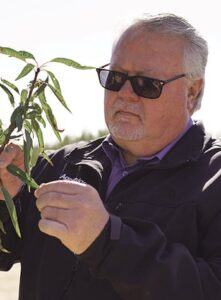Victories from the field feature growers winning battles, both small and large, by choosing the right solutions for insects and diseases. As with any challenge, growers report that overcoming obstacles on multiple fronts is essential to achieving higher yields in corn.
Derric Eisenmann from Mahomet, Illinois, is one of those growers. Every year, he’s on the front lines, fighting off pests like gray leaf spot, corn rootworm (CRW) and Japanese beetles in his cornfields. His goal is to find a program with high efficacy that increases the profit opportunity in his crops.
“I’ve done trials where I’ve only used a fungicide or only used an insecticide,” Eisenmann says. “But then I used both and received a much bigger return on investment [ROI].”
Eisenmann found that using an effective insecticide and fungicide provided a balanced attack against both insects and diseases, with robust treatment of one resulting in improved control of the other.
Over the past few seasons, he’s found success by using a combination of Trivapro® fungicide and Warrior II with Zeon Technology® insecticide from Syngenta.
“With those kinds of superior products, your ROI can go through the roof,” Eisenmann says. “I’ve seen the standability, the plant health and the control of gray leaf spot improve. We also get late-season rootworm beetles or Japanese beetles. If you’re cleaning up the beetles to protect the leaf, then you also need to enhance the leaves’ healthiness.”
I’ve done trials where I’ve only used a fungicide or only used an insecticide. But then I used both and received a much bigger return on investment.
Perennial Pests
Protecting corn against insects takes more than just spraying the right insecticide at the right time. Dependence on one seemingly perfect solution can result in exposing successive insect generations to the same mode of action, leaving those pests resistant to a once-effective chemical.
Kevin Langdon, Ph.D., product biology lead for insecticides at Syngenta, uses his entomological expertise as a representative on the Insecticide Resistance Action Committee (IRAC). Formed in 1984, IRAC works as a specialist technical group of CropLife — the national trade association for pesticide manufacturers, formulators and distributors — and provides a coordinated industry response to prevent or delay the development of resistance in insects and mites. Langdon notes that the group’s insect control philosophy has changed in recent years.
“IRAC now recommends a generational ‘windows approach,’ where one window is equal to one insect generation,” he explains. “It’s a different way of thinking that cuts down on exposure of subsequent generations to the same mode of action.”
Great Traits
Hybrids with insect control trait stacks act as a foundation for an effective corn insect control strategy and provide growers peace of mind. Corn traits help preserve yield potential and keep target pests from causing significant economic damage. Traits work in tandem with crop-applied insecticides to help manage insects effectively.
An example of this kind of protection can be seen in Syngenta traits, such as Agrisure Viptera® and Agrisure Duracade®. These traits are offered in several integrated E-Z Refuge® stacks that provide multiple modes of action against above- and below-ground insects. Agrisure Duracade and Agrisure Viptera trait stacks combine to control 16 damaging above- and below-ground pests, more than any competitive trait stack.
The discovery of Agrisure Viptera started with something that many people have experienced in their refrigerators. “One of our researchers returned from vacation and decided to study the bacterial strains in his sour milk instead of dumping it, which led to the discovery of Agrisure Viptera’s insecticidal protein, Vip3,” says Eric Boudreau, Ph.D., head of trait projects for corn at Syngenta. “Before Agrisure Viptera, yield losses from lepidopteran [above-ground] pests could be devastating. Agrisure Viptera marked a major step change in corn insect control.”
Agrisure Duracade, in particular, represents a major step forward in insect control through traits. “Duracade is unique because it’s the first engineered hybrid Bt protein,” explains Tim O’Brien, Agrisure® traits manager at Syngenta. “Our researchers combined two different Bt genes to create a unique protein that has a different binding site in the gut of corn rootworm, giving growers a novel way to combat one of agriculture’s most persistent pests.”
Even in light of these advances, O’Brien notes, it’s important to remember that Agrisure Duracade is one of the many technologies farmers may use. “Growers concerned with corn rootworm should have a multiyear management plan in place for each field that incorporates multiple control strategies, including crop rotation, CRW-traited corn hybrids, soil-applied insecticides and adult beetle management.”









